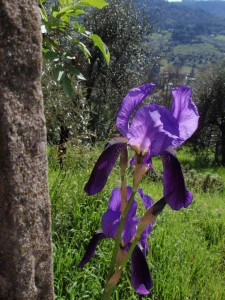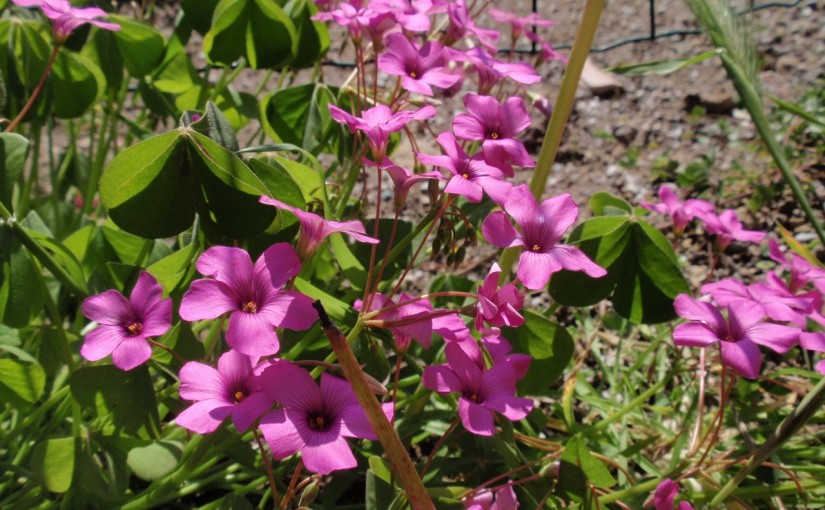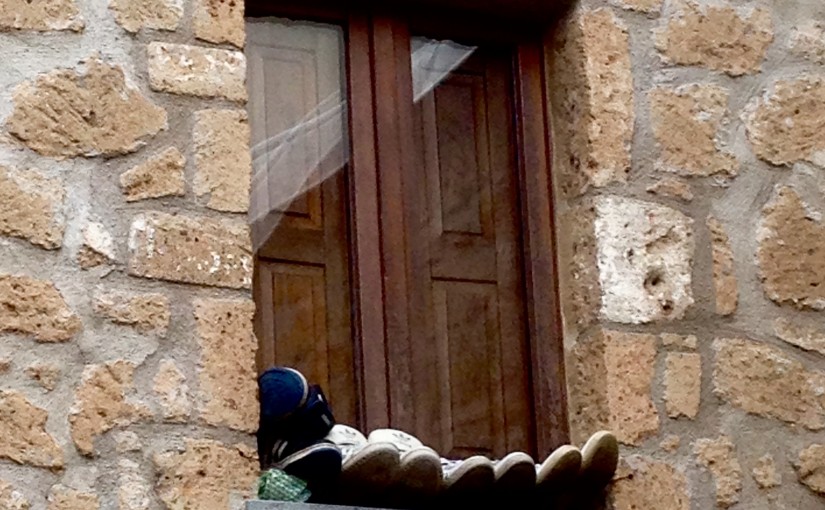I discovered the message at 8:00. “There’s a Spring Walk today in Monterubiaglio. If you want to join us, I’ll pick you up at 9:10, exactly, in Piazza della Repubblica.” From Claudia.
Monterubiaglio is a picture-perfect little town about twenty minutes from here.  So far, I’ve been to their Olive Oil Festival and their Harvest Festival. Both were exuberant beyond description. The town’s frantoio (an oil mill) produces wonderfully picante, fresh, full-bodied oil. For the Olive Oil Festival they put up a tent in their yard, put out a spread in their pressing room, added music, and attracted crowds.
So far, I’ve been to their Olive Oil Festival and their Harvest Festival. Both were exuberant beyond description. The town’s frantoio (an oil mill) produces wonderfully picante, fresh, full-bodied oil. For the Olive Oil Festival they put up a tent in their yard, put out a spread in their pressing room, added music, and attracted crowds.
The Harvest Festival was held in the piazza. An ideal square for a small Italian town, it is paved in various shades of rose and buff brick and stone, and closed on one end by a castello, also in brick and stone. Mini-piazzas sprout at three of the four corners, one before a lovely (brick) church, while the other two serve as courtyards for houses with verandas. The Harvest Festival featured a pair of open fires with chestnuts a-roasting in large perforated iron pans swinging on chains suspended from tripods, several booths vending fresh sausage you roasted yourself on a stick over other open fires, fresh wine (sparkling, and just beginning to ferment), and a local band named Organicanto that played both traditional and new music.
The band was notable; one of their original pieces would begin, for instance, with a tune from an Umbrian folk tradition, morph to something Latin American, breeze through Elizabethan Celtic, dip into Spain, Morocco, and end up in Sicilia, all without seeming the least bit contrived. It featured flute, standup base, violin, clarinet, harmonica, cornet, cello, concertina, hand drums, various sparkling percussives, and open-throated vocalists. I fell instantly in love.
So, do I want to rush my morning to go on a nature walk with Monterubiagliani? Damn straight.
 I arrived in Piazza della Repubblica two minutes early. My friend Svetlana was strolling towards me. She intuits everything and asked where I was going. Morning Italian tried to exit my mouth and failed. She patted me and continued on. Claudia was waiting, and paradoxically I explained to her – in Italian and without effort – that the first conversation of the day is always a disaster.
I arrived in Piazza della Repubblica two minutes early. My friend Svetlana was strolling towards me. She intuits everything and asked where I was going. Morning Italian tried to exit my mouth and failed. She patted me and continued on. Claudia was waiting, and paradoxically I explained to her – in Italian and without effort – that the first conversation of the day is always a disaster.
As we parked near Claudia and Enrico’s house, their sons Andreas and Tobia were playing in the piazza. I greeted, they ignored me. We went upstairs. Enrico appeared to be bumping into walls. I said hello, he ignored me. We gathered the gear required for a nature walk, and trooped downstairs. Simone, who is about twenty-six and has a developmental disorder of some kind, was hanging out with the boys. People passed and were nodded to with grunts and breathy sounds. We hiked to the bar (The Fabulous Las Vegas Bar and Pub, in English, that’s not a translation) in front of which thirty or forty solid citizens had already gathered with their children, some as young as three, ready for an adventure.
I followed the family into the bar, which is indeed, fabulous. We ordered coffee. We drank it. Enrico turns to me as if it was the first time he’s noticed I’m around (and it may have been) says, “Meglio! Depressa domenica,” and grins. I observe a house across the way. The facade is all plaster painted a kind of gray-mauve with a terra cotta plaque of a pharaoh embedded in the wall, above and to the left of the door. The door and an inset porch above the pharaoh are painted in shades of bright blue and green with shots of yellow.
Outside, the group of assembled nature walkers has grown in size. I am introduced to Francesca, who is a naturalist, or at least an expert on wild plants, and who will be guiding this morning’s tour. The word “guide” instantly sets up expectations of order and polite conformity.
About 9:50 we go off downhill. Simone takes one look at the slope and links his arm in mine. Dogs behave as if they’d never seen one another before (or are holding a grudge.) Cars come past, attentions are shouted, the line straggles down to the road to Orvieto, crosses it, and stops (sort of) in an unpaved turnoff from which emerges the old dirt road to an ex-hot springs. Francesca turns to what could be loosely defined as a group and begins to explain what she is going to be pointing out. No conversations are halted for this presentation, no children are silenced or made to pay attention, a portion of the group continues down the road. Francesca is not in the least disturbed or surprised by this, she speaks as if she were in a lecture hall before her rapt students. She concludes and, with no transition whatsoever, follows those ahead of her.
arm in mine. Dogs behave as if they’d never seen one another before (or are holding a grudge.) Cars come past, attentions are shouted, the line straggles down to the road to Orvieto, crosses it, and stops (sort of) in an unpaved turnoff from which emerges the old dirt road to an ex-hot springs. Francesca turns to what could be loosely defined as a group and begins to explain what she is going to be pointing out. No conversations are halted for this presentation, no children are silenced or made to pay attention, a portion of the group continues down the road. Francesca is not in the least disturbed or surprised by this, she speaks as if she were in a lecture hall before her rapt students. She concludes and, with no transition whatsoever, follows those ahead of her.
Another woman announces to the moving throng that there are treats waiting at the river. Claudia explains that there was a formal hot spring, now in ruins, at the end of this curving road lined with unpruned umbrella pines, and that people have been discussing its revitalization ever since it closed in the seventies.
 Francesca stops, pulls on a few plants, and describes their properties, uses, flavors, and provenance. Whoever’s around listens, smells, tastes, and takes photos. Children collect flowers as she identifies them. The woods seem to spring to life as a result of her awareness.
Francesca stops, pulls on a few plants, and describes their properties, uses, flavors, and provenance. Whoever’s around listens, smells, tastes, and takes photos. Children collect flowers as she identifies them. The woods seem to spring to life as a result of her awareness.
We approach a steeper path downwards. Simone shouts “help! help!” and links arms with Cinzia on the other side, then with Claudia. We encourage him, and he relaxes.
The group passes the old hot springs. A building with all the marks of the fifties rises high above the road in a series of terraces. It looks, in its Borsch Belt way, as if it were quite elegant of its time. It is in ruins, and ruins fascinate, so all necks become rubber as we go by. Saplings jut from balconies, creepers snake up pillars, wall flowers bloom next to naked windows.
The road becomes a trail. Simone unlinks and relinks with Enrico and another man. Francesca finds wild garlic, camomile, mustard, fennel, and a type of orchid, and shares them with whoever happens to be around. The line of hikers squiggles off in both directions and as far as I can see. A sound track from a Fellini movie plays in my head.
The trail leans steeply downhill and turns into a series of improvised rock steps. Simone returns to Cinzia, then links up with me again. We encourage him down to a stream we have to ford. The woman who announced the waiting goodies lends a hand to all who cross here. Simone is successful, everyone around applauds and calls compliments. He looks at the ground and seems content.
The river is sighted. Andreas and other children shout its name, “La Paglia!” and  their walk breaks into a run. The trail emerges directly uphill from a rapids; it’s a lovely coming out of the woods. And there, at the head of the trail as it spills towards the river, is a spread of pastry, juice, water, and pop set up on a picnic table, parts of which look like they, too, were imported. I wonder aloud how they were brought here. “By car, probably,” someone answers. By car? Where’s the road? People shrug and continue on to the water.
their walk breaks into a run. The trail emerges directly uphill from a rapids; it’s a lovely coming out of the woods. And there, at the head of the trail as it spills towards the river, is a spread of pastry, juice, water, and pop set up on a picnic table, parts of which look like they, too, were imported. I wonder aloud how they were brought here. “By car, probably,” someone answers. By car? Where’s the road? People shrug and continue on to the water.
Simone, triumphant but fatigued, sits on the bench. Claudia, Cinzia and I flank him by turns. He’s had enough adventure for the moment, so I forgo the river walk and we watch and listen to the water. “How far back to Monterubiaglio?” Simone asks. As far as we’ve come. “Will we be back by two?” We’ll get there when we get there. He nods, thinks, grins.
After everyone has snacked and played and admired, people begin to drift uphill. Simone expresses a little concern about the walk immediately ahead, but is on his feet before it can stop him, and linking arms and holding hands with whomever is available. He skips across the stream like a veteran. I find the crossing easier, too, by his example.
 More plants are identified on the climb. Children continue to collect flowers, both in hand and on telefonino. Each flower they collect, they inquire about, and Francesca speaks to them as colleagues.
More plants are identified on the climb. Children continue to collect flowers, both in hand and on telefonino. Each flower they collect, they inquire about, and Francesca speaks to them as colleagues.
As we ascend towards Monterubiaglio, she finds a flower that seems to be growing straight out of the earth. She opens her switchblade and cuts the flower open at the base. “A small insect is attracted by the odor that arises from the pollen deep inside the flower. Once the insect enters, the flower closes above the chamber, and the insect is trapped. Happily trapped, however, for it has plenty to eat. As it feasts, the flower wilts and dries, eventually opening cracks in the side of the chamber. The insect, having had its fill, leaves, takes along the pollen that has stuck to it, is attracted to another of the same flower, and the cycle continues. Brilliant symbiosis.” The plant is called Poor Man’s Tapioca because the root was dried, ground, and used to extend flour in times of want.
A young woman finds a wild orchid. She is asked by someone if she’s going to pick it. “No,” she replies, “it’s very rare, and too beautiful to pick.” Simone has gone up into town on this own.

